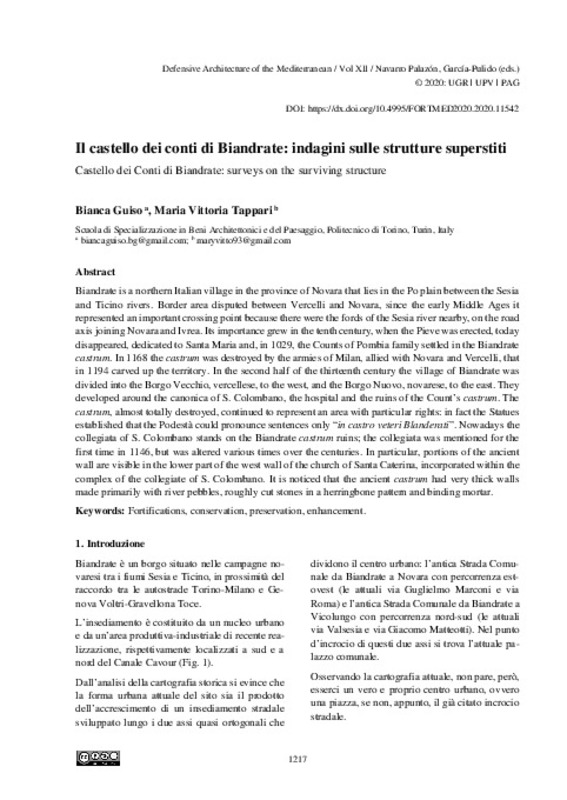JavaScript is disabled for your browser. Some features of this site may not work without it.
Buscar en RiuNet
Listar
Mi cuenta
Estadísticas
Ayuda RiuNet
Admin. UPV
Il castello dei conti di Biandrate: indagini sulle strutture superstiti
Mostrar el registro sencillo del ítem
Ficheros en el ítem
| dc.contributor.author | Guiso, Bianca
|
es_ES |
| dc.contributor.author | Tappari, Maria
|
es_ES |
| dc.coverage.spatial | east=8.4644471; north=45.4482748; name=Via Giacomo Matteotti, 28061 Biandrate NO, Itàlia | es_ES |
| dc.date.accessioned | 2020-07-20T07:40:18Z | |
| dc.date.available | 2020-07-20T07:40:18Z | |
| dc.date.issued | 2020-05-15 | |
| dc.identifier.isbn | 9788490488560 | |
| dc.identifier.uri | http://hdl.handle.net/10251/148304 | |
| dc.description.abstract | [EN] Biandrate is a northern Italian village in the province of Novara that lies in the Po plain between the Sesia and Ticino rivers. Border area disputed between Vercelli and Novara, since the early Middle Ages it represented an important crossing point because there were the fords of the Sesia river nearby, on the road axis joining Novara and Ivrea. Its importance grew in the tenth century, when the Pieve was erected, today disappeared, dedicated to Santa Maria and, in 1029, the Counts of Pombia family settled in the Biandrate castrum. In 1168 the castrum was destroyed by the armies of Milan, allied with Novara and Vercelli, that in 1194 carved up the territory. In the second half of the thirteenth century the village of Biandrate was divided into the Borgo Vecchio, vercellese, to the west, and the Borgo Nuovo, novarese, to the east. They developed around the canonica of S. Colombano, the hospital and the ruins of the Count’s castrum. The castrum, almost totally destroyed, continued to represent an area with particular rights: in fact the Statues established that the Podestà could pronounce sentences only “in castro veteri Blanderati”. Nowadays the collegiata of S. Colombano stands on the Biandrate castrum ruins; the collegiata was mentioned for the first time in 1146, but was altered various times over the centuries. In particular, portions of the ancient wall are visible in the lower part of the west wall of the church of Santa Caterina, incorporated within the complex of the collegiate of S. Colombano. It is noticed that the ancient castrum had very thick walls made primarily with river pebbles, roughly cut stones in a herringbone pattern and binding mortar. | es_ES |
| dc.language | Italiano | es_ES |
| dc.publisher | Editorial Universitat Politècnica de València | es_ES |
| dc.rights | Reconocimiento - No comercial - Sin obra derivada (by-nc-nd) | es_ES |
| dc.subject | Fortifications | es_ES |
| dc.subject | Mediterranean | es_ES |
| dc.subject | Modern age | es_ES |
| dc.subject | Built Heritage | es_ES |
| dc.subject | Conservation | es_ES |
| dc.subject | Preservation | es_ES |
| dc.subject | Enhancement | es_ES |
| dc.title | Il castello dei conti di Biandrate: indagini sulle strutture superstiti | es_ES |
| dc.title.alternative | Castello dei Conti di Biandrate: surveys on the surviving structure | es_ES |
| dc.type | Capítulo de libro | es_ES |
| dc.type | Comunicación en congreso | es_ES |
| dc.identifier.doi | 10.4995/FORTMED2020.2020.11542 | |
| dc.rights.accessRights | Abierto | es_ES |
| dc.description.bibliographicCitation | Guiso, B.; Tappari, M. (2020). Il castello dei conti di Biandrate: indagini sulle strutture superstiti. Editorial Universitat Politècnica de València. 1217-1224. https://doi.org/10.4995/FORTMED2020.2020.11542 | es_ES |
| dc.description.accrualMethod | OCS | es_ES |
| dc.relation.conferencename | FORTMED2020 - Defensive Architecture of the Mediterranean | es_ES |
| dc.relation.conferencedate | Octubre 01-03,2020 | es_ES |
| dc.relation.conferenceplace | Granada, Spain | es_ES |
| dc.relation.publisherversion | http://ocs.editorial.upv.es/index.php/FORTMED/FORTMED2020/paper/view/11542 | es_ES |
| dc.description.upvformatpinicio | 1217 | es_ES |
| dc.description.upvformatpfin | 1224 | es_ES |
| dc.type.version | info:eu-repo/semantics/publishedVersion | es_ES |
| dc.relation.pasarela | OCS\11542 | es_ES |








